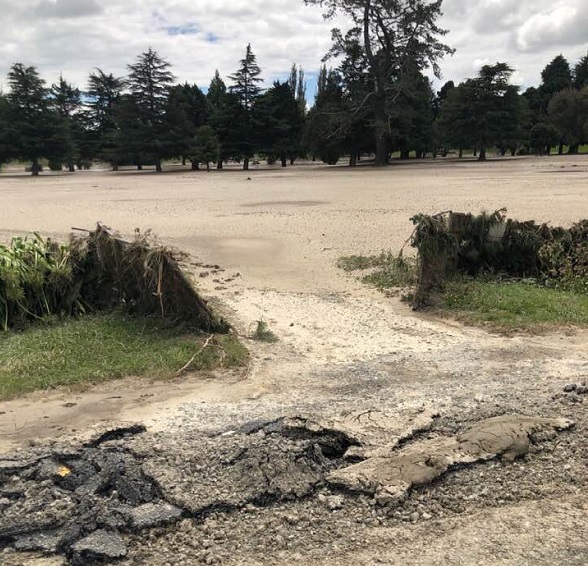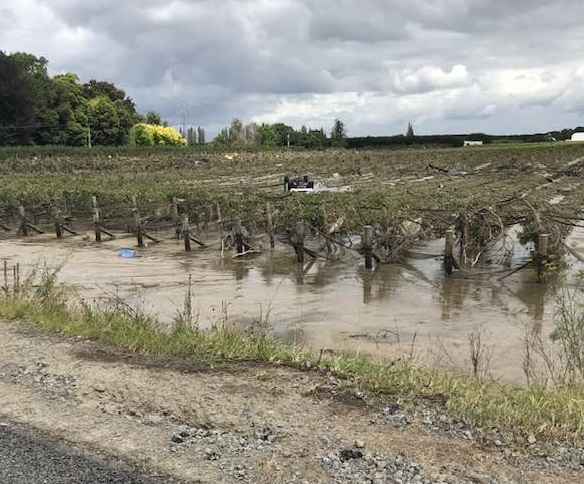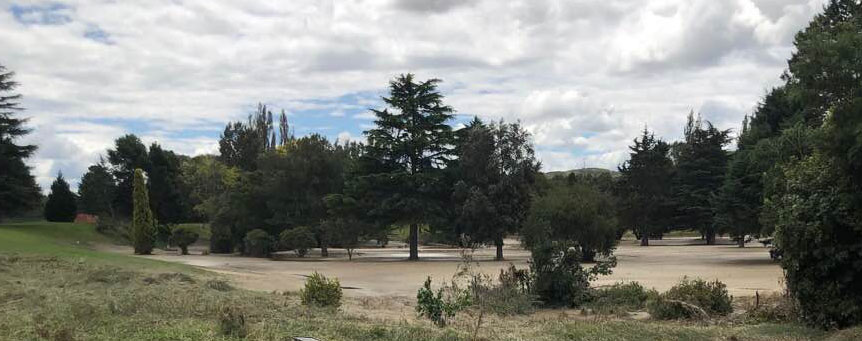
This photo (by John Hancock) shows what was a vineyard at the boutique winery Shed Five Thirty in the Hawke’s Bay settlement of Puketapu. The photo below is a vineyard at Links Road, near Waiohiki.

Vineyards in New Zealand’s key grape-growing regions of Hawke’s Bay, Gisborne and Northland have been smashed by flooding caused by Cyclone Gabrielle – one of the worst storms to hit New Zealand in living history. There are reports of vineyards washed out to sea, with waves recorded as high as 11 metres along some coasts.
Many vineyards in the south of the North Island are like this – completely submerged just weeks before the start of the grape harvest. The extent of the damage won’t be known for some time, with communications and access to some vineyards still cut off by high waters and landslides, so we sent Wine-Searcher’s Oliver Styles out to assess the impact of the cyclone...
'Vineyard tracks are small streams'At first glance, there’s little amiss – the vineyards of Gimblett Gravels, Bridge Pa, and further inland are, other than their verdant canopies and surrounds, unremarkable. But landslides dot the hillsides – one has come down from Roy’s Hill (the hill that overlooks both Gimblett Gravels and Bridge Pa from the north) and onto State Highway 50.
Another – one of several – has come down from the Te Mata hillside onto the road that leads to the Craggy Range cellar door in the Tuki Tuki river valley. It’s one of the most photographed spots in Hawke’s Bay, with shots taken from Te Mata peak, looking out across the valley, with the cellar door, restaurant and show vineyard below, the river gently winding through it all towards the sea. Two days ago, the river was a khaki surge, the tops of trees visible on the opposite bank and orchards, planted on the lower-lying flats, under water.
But it appears, from a cursory glance, that the vineyards between the Tuki Tuki and the Ngaruroro have been spared the worst. There are pools of water where there shouldn’t be pools of water; part of Bridge Pa is flooded – the small Paritua stream that runs along the southern line of the Bridge Pa wine region has clearly flooded lower down but, according to Paritua winery’s viticulturist, their section of the eponymous stream was no higher than it was in the last major rain event two weeks ago.
Elsewhere, some vineyard tracks are small streams and, here and there, vine trunks poke up out of ponds. The actual damage (in terms of disease pressure via mildew, etc, combined with berries splitting as the vines take up all that hydration) will only really become known over the next few weeks.
'The death toll will be much larger than it is at present without doubt'But the cyclone wasn’t the biggest problem for vineyards. As Warren Gibson, winemaker at Trinity Hill, explained to Canopy: “I’m not sure the greater population quite understands the depth of the situation for so many people and their properties. The big problem was not so much the volume of rain in Hastings/Napier but inland north and west, which resulted in the rivers being seriously overloaded. The bridges then acted like dams resulting in diverting of the flow and breaching of the stopbanks. The devastation started just past Trinity Hill at Fernhill where the Ngaruroro breached the stopbank. The Tutaekuri, Esk and maybe Tukituku rivers also breached.
“Esk Valley and surrounds plus Ohiti and the general area after Fernhill are devastated. Houses, orchards, vineyards and, devastatingly, numerous people gone. The death toll will be much larger than it is at present without doubt.”
But he said his team are safe and well.
Oliver went out a few days later to describe the scene after the rivers burst their banks…
'There are caravans, upside down, in the trees of apple orchards'The silt on the roads is turning to dust where the car wheels are tracking and loose apples, picked up and deposited by the waters, covered in dry mud and resembling dusty balls, cluster and pool in groups of varying quantity at the roadside. Apples, squash and indeterminate vegetables look like rounded rocks after a river has been drained. They run along the roadsides like a Braille carpet.
Where the fences are still standing (the rest look like they have been pushed over by a mob of tractors), they look like camouflage nets – the fencewires have caught the hay, grass and debris washed along with the river; some are so thick they look like matting suspended vertically.
I drive through a settlement and there are caravans, upside down, in the trees of apple orchards. Silage bails lie, higgledy-piggeldy, in the ditch. RSE workers (the guys – it’s predominantly guys in Hawke’s Bay – from the Pacific Islands who come to harvest grapes and apples) are manoeuvring an empty 1,000L plastic cube tank in a driveway. One house looks as if it has vomited thick mud, the colour of dark chocolate, down the front doorsteps. Each house has had a shape and code spray-painted on it by the disaster relief teams, showing the date it was declared clear and other hieroglyphs undecipherable to the untrained eye. A huge tree, its upper branches visible from the car, is wedged against a pillar in the middle of the bridge across the Tutaekuri river.
Nothing, though, quite prepares you for the devastation in the Esk Valley. Here, the silt washed across the valley by the Esk river is measured not in centimetres, but metres. There are orchards where the silt is above or level with the top of the fenceposts supporting the fruit trees. In some cases, it is impossible to tell what type of fruit was being grown in a particular orchard.
The railway tracks have been disassociated from the ballast and swept to the side. They hang, draped between solid objects, above pools of water that look like half-filled craters. In one section the track has split and the force of the water has twisted the rails into a hairpin. That’s when I gasped. A railway line bent back onto itself like a hairpin.
The road (here, it’s State Highway 5) appears to lie under shifting sands – as if, like some ancient byway, it had to be uncovered by archaeologists. In parts, it is almost washed away; in others, the water has undermined the tarmac and it is cracking as if a giant has been snapping off bits of asphalt to snack on.
‘The earth has come back to us’A tractor has been washed across a paddock and lies, on its side, by the fence in a mess – its chevron-patterned rubber tyres the only real indication as to what it is. A quadbike is upside down, three-quarters buried in silt in the ditch. The force of the flood has rent car doors backwards, punched into bonnets, smashed windscreens and forced vehicles to back up onto piled-up silt. A pair of windscreen wipers hang limp, like two emaciated broken legs.
Three animal corpses – one is either a sheep or a goat – their fur the same colour as the road and the fields, are in a macabre pile on the hard shoulder. The hard shoulder itself has been cut out of the mud in places and resembles a brown snowdrift.
The silt is everywhere. In the cellar where we go to help, it’s so fine it feels like prizing bottles of wine from soft clay or like trying to pull a bottle out of the sand at low tide.
They have to chainsaw and angle-grind their way in through the walls to get into the building – the mud is so high outside and in. The emergency services have tagged the presence of two gas cylinders, their tops only just dug out of the mud, on the outside wall. Inside, you climb silt then wade through watery mud, the mud filling your boots as you move between pallets of bottles. The cardboard is saturated and comes away in your hand, revealing bottles of wine plastered with more cardboard dividers; you feel blindly into the murk and drag them out, bottle by bottle. The bottles slip in your hands, greased with silt. In there, it is just the sound of sloshing and the laboured breathing of your neighbour, the chink of glass, shouts, grunts and the odd joke – a smile, laughter.
By now mud is everywhere, covering arms, legs and clothes, wiped across foreheads and planted by hands on walls as people try not to lose their balance in the shin-deep quagmire. The only place you can wipe your mouth is the inside collar of your T-shirt. You don’t want to ingest it and you don’t want cuts – the microbial underworld has joined us.
Outside in the sun, the mud dries on limbs, caking and cracking on them, and pulling the skin when you squat, move or stretch. You rub it off and it turns to fine dust. It’s the same fine dust produced by the top layer of silt in the fields all around. It’s picked up by the wind and you breathe it in. It feels grainy between your teeth for the rest of the day.
The earth has come back to us.
On returning home we hear winemaker Philip Barber has spent two days digging out 12,000 bottles of wine at Petane Wines. They were stuck in a cold room behind a 3m-high load of silt jammed inside the shed where he makes wine, and his brother Chris makes beer for Zeelandt Brewery. The bottles have gone for testing and will be auctioned to recoup some of the costs. The wine wasn’t insured.













.png)






